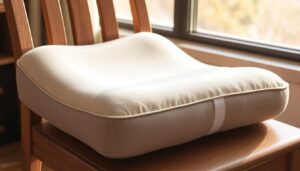Holding your newborn for the first time mixes joy with challenges. This includes taking care of them day and night. It’s crucial to ensure their safety and happiness. But, don’t forget about your own health during these times. Baby care ergonomics can help, making things easier for both you and your baby. From feeding in the wee hours to fun playtimes, our guide covers ergonomic baby products and best baby care tips. They help create a loving, comfy space for your child and keep you healthy and comfortable.
Parenting is a big step, but you can do it confidently with our help. We’ll show you the basics of ergonomically designed baby essentials. They make everyday parenting a mix of care, love, and comfort. It’s all about finding the right balance, and we’re here to help you achieve it.
Key Takeaways
- Discover the importance of ergonomics in your baby care routine for a healthier, happier experience.
- Learn to select the best ergonomic baby products that provide optimal support for your infant’s development.
- Gain insights on how ergonomically designed baby essentials can enhance your parenting experience and comfort.
- Build your understanding of safe lifting and carrying techniques to protect your body while caring for your baby.
- Access practical tips for integrating ergonomics into every aspect of baby care, from feeding to sleeping.
- Utilize our comprehensive guide as a compass for navigating parenthood with ease, thanks to baby care ergonomics.
Understanding Ergonomic Baby Care
Ergonomics matter a lot in life, especially in baby care. It’s crucial because it keeps both the child and caregiver healthy and comfortable. Using ergonomics in the nursery and daily routines helps your baby grow well. It also keeps you from getting hurt or uncomfortable.
Adding ergonomic nursery setup and infant ergonomic positioning to your daily care makes everything safer and easier. Let’s find out why these are important.
Importance of Ergonomics in Baby Care
A good ergonomic setup in baby care reduces strain for parents and caregivers. It helps avoid pain from tasks like lifting and feeding. Also, it supports a baby’s physical growth, ensuring they have proper posture during their quick-growing early years.
Core Principles of Baby Care Ergonomics
Start with the basics for infant ergonomic positioning: pick the right furniture and accessories. An ergonomic nursery setup should include adjustable cribs and comfy chairs for feeding. Every item should make you and your baby comfortable and support your baby’s posture.
- Look for a crib you can adjust so you don’t have to bend too much.
- Pick a changing table at a good height to avoid stooping.
- Find a feeding chair that keeps your back comfy while you feed your baby.
It’s vital to think about infant ergonomic positioning when holding, feeding, and sleeping. The right baby carriers, strollers, and bath gear help keep you and your baby in good posture. These items are key for you both to be comfortable and aligned.
Optimal Spine and Hip Support for Infants
Choosing ergonomic baby products is key. They help support your baby’s spine and promote healthy hip growth. These products keep an infant’s body in a natural position. This protects their development during the vital early years.
Identifying Ergonomic Baby Products
Good ergonomic products give your baby the support they need, focusing on the hips and spine. For example, baby carriers allow the baby’s hips to stay in a “M” position. This is where the knees are higher than the buttocks. This position helps prevent hip problems like hip dysplasia. Also, these products let the baby’s spine curve naturally. They avoid making the spine too straight, which could cause discomfort or injury.
Ergonomic gear does more than just protect your baby’s spine. It also helps with their development over time. By promoting the right posture early on, these products support the growth of healthy postures. This helps with physical alignment and better movement as they grow.
Look at all the choices out there and pick the best for spine and hip health. The goal is to mix comfort with support for smooth growth and wellness.
Increase Parent Comfort with Ergonomic Products
To greatly increase parent comfort, it’s important to pick ergonomically designed baby essentials. These items help lessen the physical stress parents often face, like back pain from holding baby. With features like adjustable straps, padded support, and even weight distribution, they make looking after your baby easier.
For instance, ergonomic baby carriers spread your baby’s weight evenly. This makes it easier on your hips and shoulders. Similarly, good nursing pillows take pressure off your back and arms when you’re feeding your baby.
- Adjustable baby carriers with lumbar support
- Ergonomically shaped nursing pillows for various feeding positions
- Strollers with adjustable handle heights to keep you from stooping
By picking products that keep you in a good posture and lessen strain, you avoid health problems. Plus, you get to spend more, pain-free quality time with your baby. Always remember, if you’re comfortable, you’ll be a happier parent!
Extending Babywearing Comfort
Looking for ways to make babywearing better? Focus on extending babywearing comfort. It’s about more than just lasting longer; it’s about making sure you and your little one are comfy and happy. Learn how ergonomic tools for baby care can change your parenting life.
To carry a baby without back pain, choose the right carrier. It should spread the baby’s weight evenly on your back and shoulders. This is key to avoid getting tired or uncomfortable when wearing your baby for a long time. Picking carriers made for comfort helps support your baby’s posture and looks after your body too.
- Invest in a quality ergonomic carrier that supports extended use.
- Look for carriers with adjustable straps and ample padding.
- Ensure the carrier you choose promotes an optimal position for your baby’s development.
- Consider carriers with breathability and lightweight materials for increased comfort.
The secret to extending babywearing comfort is valuing features that ensure you and your baby are safe and comfy. Adding ergonomic ideas into your babywearing can make it fun, not just something you have to do.
Babywear Longer and Stronger: The Ergonomic Way
Choosing the ergonomic way to babywear longer greatly helps you and your baby. It focuses on the right babywearing posture and safe baby lifting techniques. These steps ensure you and your little one can stay close for longer times without feeling uncomfortable or strained.
For the best ergonomic experience, here’s a handy guide on picking and using a baby carrier. This guide emphasises long-term use and safety:
- Choose a Supportive Carrier: Pick a carrier that supports your baby’s back and hips well. It should keep the baby’s legs in an “M-shaped” position. This spreads the weight equally and helps with proper hip growth.
- Adjust for Fit: Make sure the carrier fits you perfectly and comfortably. This avoids stress on your back and shoulders and lets you babywear longer.
- Practice Safe Lifting: When putting your baby in the carrier, use safe baby lifting techniques. Always squat instead of bending from your waist. Keep your baby close as you lift them.
- Monitor Baby’s Position: Check often to make sure your baby is sitting correctly. The carrier should hold your baby’s head and keep their airway clear.
- Build Endurance Gradually: Start with short babywearing sessions. Increase the time slowly to get you and your baby used to it.
Focus on these points for a better babywearing experience. You’ll bond more with your baby, while staying healthy and comfortable. Starting right with safe baby lifting techniques and the best babywearing posture leads to happier, longer babywearing times.
Strengthening Parent-Child Bonds Through Ergonomics
Ergonomics in baby care does more than just physically support your baby. It’s crucial for strengthening parent-child bonds. By using ergonomic baby slings, you keep your baby close. This helps build a strong, loving relationship.
Parent-child bonds are boosted with ergonomic babywearing. This practice is comfy and safe. It also connects you two emotionally. Your baby stays close to your warmth and heartbeat.
- Ergonomic items boost closeness, making your baby feel safe and loved.
- Ergonomic baby slings let you and your baby interact more, helping with their learning and feelings.
- Being close in an ergonomic sling raises oxytocin levels, the ‘love hormone’. This strengthens your bond.
Using ergonomic slings and carriers offers more than comfort and support. They help build a lasting, love-filled bond with your baby. Each moment becomes more meaningful and heartwarming.
Ergonomic Nursery Setup Tips
Considering an ergonomic nursery setup is key when arranging your baby’s room. It boosts comfort and safety for both you and your child. It ensures you can look after your baby easily, without hurting yourself. Plus, it creates a supportive space for your baby’s growth.
Small details in nursery design can greatly reduce your physical stress. Choosing the right furniture and accessories makes the room look good and function well. An ergonomic setup, with ease of use and good posture in mind, is essential for health and wellbeing.
Designing an Ergonomic Nursery Space
- Choose a crib that lets you change mattress heights. This saves your back as your baby gets taller.
- A comfy rocking or gliding chair with lumbar support is key for late-night feeds or calming your baby.
- The changing table should be tall enough to use without bending over. This prevents back pain. Keep essentials close to avoid stretching too far.
Choosing Ergonomically Designed Baby Essentials
- Pick best baby carriers for back support that evenly spread weight to prevent back strain.
- Choose ergonomic baby seats and bouncers. They give proper support for your baby’s head and back, aiding their posture.
- Look for certified ergonomic baby products. Certifications from pediatric groups show they’re good for your baby’s development and ergonomic.
Using these ergonomic principles makes your nursery safe and beautiful. It boosts wellbeing for you and your child. The effort in making an ergonomic nursery is worth it. It brings comfort for you and health and joy for your baby.
Baby Care Ergonomics
Embracing baby care ergonomics is key to a pain-free care routine for you and your baby. It helps avoid strain from repetitive baby care tasks. This approach also makes sure the caregiver stays well.
Using ergonomic tools and methods in daily baby care reduces stress and discomfort. This is true whether you’re feeding, bathing, or changing diapers. Ergonomic principles can greatly lower the risk of strain.
| Activity | Ergonomic Solution | Benefits |
|---|---|---|
| Diaper Changing | Adjustable-height changing table | Reduces bending and back strain |
| Bathing | Baby bath with support | Prevents overreaching and maintains a good posture |
| Feeding | Ergonomic nursing pillows | Supports back, neck, and arm during breastfeeding or bottle feeding |
Remember, balancing your comfort and your baby’s health is key for a pain-free baby care routine. With the right baby care ergonomics, you can fully enjoy the early months without discomfort.
Safe Baby Lifting Techniques
Being a new parent requires learning how to lift your baby safely. It’s crucial for both your health and your baby’s safety. Knowing the right way to lift after you’ve had a baby helps avoid injuries. It also makes caring for your little one easier.

How To Lift and Carry Your Baby
Begin by standing close to your baby. Then, bend your knees and squat to get to their level, keeping your spine straight. With both hands, lift your baby from under their armpits.
Hold them close to your chest as you straighten your legs to stand. Making sure your baby is secure against you helps with balance and safety.
Preventing Back Pain While Caring for Your Baby
Using the right posture when lifting and holding your baby is key to avoid back pain. Keep your baby close to reduce strain on your arms and back. If you’ll be holding them for awhile, think about using a baby carrier. It helps share the weight more evenly.
| Technique | Benefits | Common Mistakes |
|---|---|---|
| Squatting and Lifting | Prevents back strain by using leg muscles | Lifting with a straight back or twisted posture |
| Using Both Hands | Ensures baby’s safety and security | Lifting the baby with one hand under the armpit |
| Keeping Baby Close | Reduces the load on your arms and back | Holding the baby away from the body |
Ergonomic Babywearing for You and Your Baby
Starting babywearing can change how you parent. It brings you closer to your baby and makes things more comfy. The trick is to find your perfect baby carrier and learn how to carry your baby right. This suits your day-to-day life and your baby’s growing needs. With the right carrier, you can ensure both of you are safe and happy, no matter where you are.
Talking to a pro babywearing consultancy is a smart move. They can show you all the options and their perks to help you choose wisely. They teach you learn baby carrying positions that are safe for you and your baby.
| Carrier Type | Features | Best For |
|---|---|---|
| Wrap | Flexible fabric, multiple tying styles | Newborns and young infants |
| Structured Carrier | Adjustable straps, built-in support | Older infants and toddlers |
| Sling | Single piece of cloth, easy to adjust | Quick trips and casual wear |
Different carriers have unique benefits. For example, wraps are super snug, great for tiny babies. Structured carriers give more back support, good for bigger babies. Slings are easy for short trips.
Finding the right carrier is a personal journey. Try out various types and talk to experts. The best choice depends on your baby’s age, your body, and how you live. A good carrier keeps your baby safe and comfy. Plus, it makes parenting smoother and more fun.
Nursing and Feeding with Ergonomics in Mind
When feeding your baby, nursing ergonomics can help ease physical discomfort. Many new parents face neck, shoulder, or wrist pain. But, with correct techniques and tools, you can lessen or avoid these pains, making feeding more pleasant for you and your baby.
Using ergonomic principles during feeding isn’t only for comfort. It also promotes health through proper posture and support. Let’s look at how the right feeding positions that reduce neck and shoulder pain and ergonomic tools improve feeding.
Reducing Neck and Shoulder Pain During Feeding
It’s important to pick the right feeding position to reduce body strain. Here are some suggested positions:
- The “cross-cradle” hold lets you support your baby’s head with the opposite hand. This gives a balanced workout to your arms and shoulders.
- If you’ve had a cesarean section, the “football hold” is useful. It keeps baby’s weight off your abdomen.
- Leaning back a bit can also take pressure off your back, neck, and shoulders. This makes it easier to feed without straining.
Ergonomic Tools and Pillars for Feeding Support
To boost your nursing ergonomics, think about getting ergonomic tools and pillows:
- Nursing pillows wrap around you, lifting your baby to breast level. This avoids leaning over, which can cause back and shoulder pain.
- Adjustable nursing stools help you sit correctly, with your feet supported. This aligns your spine properly.
- Ergonomic chairs with proper back support make feeding more comfy. They help you avoid wrist pain when feeding baby.
Adding these methods to your routine can enhance the nursing experience. You’ll focus more on bonding with your baby, not on discomfort. This makes those moments even more special.
Diaper Changing: An Ergonomic Approach
Changing diapers the right way is key to avoiding discomfort and back pain. Learning to change a diaper properly can make this daily task good for your health.

First, pick a changing area that meshes with your height. Doing so means you won’t have to bend in awkward ways, which helps your back. The spot should let you care for your baby easily without stooping.
- Keep all necessary supplies within easy reach. This keeps diapers, wipes, and creams close by, so you don’t stretch or twist too much.
- Maintain a neutral spine. Make sure your feet are firmly on the floor, your hips even, and your back straight. This way, your back is supported and you can move easily.
Following these tips makes changing diapers better for you and your baby. By using ergonomic methods, you and your baby can enjoy these moments more comfortably and safely.
Infant Ergonomic Positioning Explained
Infant ergonomic positioning is essential for your baby’s comfort and growth. It keeps your baby’s body in alignment. This supports their natural development, helps them move better, and improves their wellbeing. Using ergonomic baby care tips, you can greatly benefit your infant’s health early on.
To grasp infant ergonomic positioning, know it’s crucial to keep your baby’s spine naturally curved. It’s important for healthy hip growth and lets their arms and legs move freely. This method avoids developmental problems, boosts comfort, and makes taking care of your baby easier and happier for you both.
| Age Bracket | Recommended Position | Benefits |
|---|---|---|
| 0-3 Months | Supine Position | Promotes a safe sleep environment, aligns the spine naturally. |
| 3-6 Months | Tummy Time | Strengthens neck and upper body muscles, enhances motor skills. |
| 6+ Months | Supported Sitting | Encourages posture development, provides opportunity for interaction and play. |
Using these ergonomic baby care tips promises comfort and safety for your baby’s vital early months. For example, a baby carrier that supports the ‘M’ position is key for healthy hips. Ergonomic mattresses and sleeping positions prevent flat spots and keep the spine aligned properly. Each little change in how your baby is positioned can boost their growth and development significantly.
Ergonomic Bath Time Setup for Babies
Making an ergonomic bath time setup for babies is key for both your little one’s and your comfort and safety during bath time. It involves ergonomic tools that help your baby’s posture, make your moves easier, and relieve stress on your body.
An ergonomic bath time setup for babies has tools made to help make bath time easier and more comfortable. Imagine a baby bath seat that supports the spine well and keeps the baby from slipping. Or, solutions that let you adjust the height so you don’t have to bend or stretch too much.
| Feature | Benefit | Description |
|---|---|---|
| Supportive Baby Bath Seat | Prevents Slipping | This seat holds the baby securely, reducing strain and risk during bathtime. |
| Non-Slip Mats | Improves Safety | Placed in and around the tub area to prevent slips and falls, ensuring a safe environment. |
| Adjustable Height Bath Tubs | Reduces Parent Strain | Bath tubs which can be adjusted to the parent’s height to avoid unnecessary bending or straining of the back. |
| Reachable Storage Areas | Minimizes Stretching | Keeps essential bathing items within arm’s reach to streamline the process and reduce movement. |
Adding ergonomic tools for baby care not only improves your bath setup but also makes the experience better. With a comfortable and secure baby, you can spend more time bonding and less time worrying about the bath logistics.
Conclusion
We’ve looked at everything from ergonomic nurseries to correct ways to lift your baby. We hope you’ve learned valuable tips for ergonomic baby care. These tips aim to make life easier and pain-free for you and your baby. Using these ideas is a way to care for the health and happiness of your family. It makes each moment with your newborn comfortable and good for them.
Ergonomic baby care is about more than nice-looking items. It’s about using the right products, being safe, and knowing how your body moves. When you focus on ergonomics, you help your baby grow well. You also keep yourself from getting hurt. This guide has everything you need to make ergonomics part of caring for your child.
In short, understanding newborn care ergonomics makes your role as a parent better. By choosing the right products and being caring and safe, you’re setting up for long-term success. These tips can help you build a caring routine that’s also comfortable. Making ergonomic choices means creating the best experience for you and your little one.
FAQ
Why is ergonomics important in baby care?
What are the core principles of baby care ergonomics?
How do I identify ergonomic baby products?
Why is support critical for infants’ long-term development?
How can ergonomic products increase a parent’s comfort?
What is the ergonomic way to wear my baby?
How does babywearing promote parent-child bonding?
What are some tips for setting up an ergonomic nursery?
What techniques should I use to lift my baby safely?
How can I find the perfect baby carrier for ergonomic babywearing?
What ergonomic tools can help with feeding and nursing?
How can I change diapers ergonomically?
What does infant ergonomic positioning entail?
How do I create an ergonomic bath time setup?
Related Posts
- How Moms Can Relieve Neck Pain from Daily Stress
- Top 5 Ergonomic Strollers for Active Moms
- The Ultimate Guide to Ergonomics for Work-From-Home Moms
- Start Here
- How to Relieve Postpartum Back Pain at Home
- Standing Desk Tips for Work-at-Home Moms
- Pregnancy Posture Mistakes and How to Fix Them
- Contact Ergomomics







